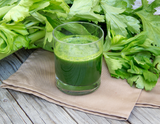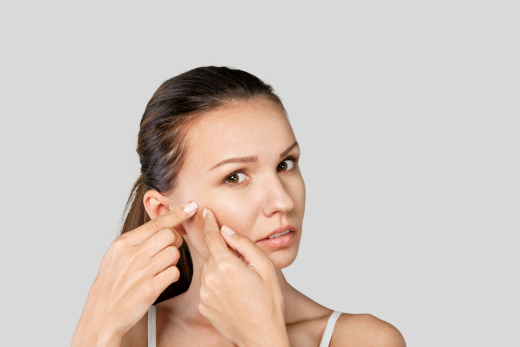"Ugh, not another one. Make it stop!" you might say to yourself as you see yet another pimple pop up on your face. Feeling your desperation grow at, seemingly, the same uncontrollable rate as your breakout, you decide to cancel your plans for the night - or perhaps you do indeed join your friends out as planned, but spend the whole time feeling awkward and self-conscious about this most recent eruption.

As anyone who has struggled with acne can tell you, the negative effect that skin issues can have on one's self-confidence can be devastating. Even though it can feel like an isolating experience, just know you are not alone. In fact, according to the American Academy of Dermatology, acne is the most common skin condition, affecting around 50 million Americans every year.
So what can be done about it?
The conventional treatments
Counterintuitive perhaps, but behind an oily, acne-prone skin is often a base condition of dryness and dehydration. Despite this fact, many conventional treatments for breakout-prone skin involve drying out the skin further.

Harsh exfoliation, acids, peels, drying products, and antibiotics can disrupt the skin’s balance and weaken the barrier. Initially, this strategy might appear effective, but over time, the body reacts by producing more oil, leading to further imbalance and subsequent breakouts. (Learn more about this negative loop + what your body is trying to tell you in this blog post).
The conventional approach is to then turn to even more aggressive treatments, perpetuating the cycle.
The holistic approach
Instead, consider a holistic approach of addressing inflammation + hormones internally (click here for our blog post on inflammation and what to do about it) and a straightforward skincare routine that restores balance.
Low-grade, continuous inflammation is increasingly common and applying a two-pronged, internal + external approach can really make a difference. An antiinflammatory diet that is low in sugar, an adequate amount of exercise, balancing hormones through a cortisol-reducing meditation practice, and perhaps a few targeted supplements recommended by your doctor can go a long way for internal balance. Many people also see good effects on their skin by avoiding dairy and/or gluten, which can increase inflammation.

It is worth noting that, contrary to the conventional method, working with the body rather than against it commonly requires a bit of extra patience, as strategies promising instant effect often are too harsh and only temporarily silence the skin, but don't actually heal the condition underneath.
5 easy, skin-friendly tips that won't break the bank:
- Change your pillowcase. Oil, sweat, and bacteria transfer to your pillowcase as you sleep and can worsen breakouts. Changing pillowcase a couple of times per week is ideal, especially for side sleepers. A silk or mulberry silk pillowcase can further help reduce irritation and helps your skincare products absorb to your skin - not your pillowcase. While you're at it, regularly changing the towel you dry your face with helps too, as bacteria can accumulate in a moist towel over time.
- Diet support. A balanced diet is the best, but a good quality supplement can help, too - just make sure to consult with your doctor. Zinc has been shown to help regulate the skin's oil (called sebum) production and lower inflammation. A quality probiotic can help support a healthy gut, which is intimately tied to balanced skin. Omega-3 is antiinflammatory and helps to improve moisturization in the skin, while magnesium is useful for barrier repair, to regulate the skin's pH, and lower cortisol, which in turn can help with hormone balancing. However, there are many types of magnesium. Some of the more inexpensive kinds, such as magnesium oxide or magnesium citrate can be harder to digest and have a laxative effect, but many find for example magnesium glycinate to be better absorbed by the body.
-
Celery juice. Alkalizing, strongly antiinflammatory, supportive of gut and liver health, and full of vitamin K, A, C, drinking a glass of celery juice in the morning on an empty stomach is a popular way to support glowing skin. Even though there's limited scientific studies behind it, we are many who have seen firsthand celery juice's positive effects on our skin over time. It might take a few weeks for it to work, so patience is key. Making a fresh celery juice at home is ideal, as many premade juices can contain added sugars and hard-to-digest preservatives. The taste can take a bit getting used to, but start by adding a bit of cucumber or a lemon and build up from there. Throughout the day, also don't forget to drink plenty of water to hydrate from within.

- Less is more! With the beauty industry full of buzz words and trendy skincare ingredients, it's easy to end up with an elaborate, multi-step routine that actually does more harm than good. Stressing an already imbalanced skin by adding multiple actives and more products than the body is able to take in can exasperate acne, deplete the barrier, and sensitize the skin further. Scaling back to a non-stripping cleanser and a deeply nourishing, balancing moisturizer might feel like you're not doing much, but is oftentimes exactly what your body needs to restore harmony.
- Prioritize sleep. Getting quality sleep, ideally going to bed at or around 10pm, boosts your body's repair processes, balances hormones, and reduces inflammation. Just like for young children, many people find that having a steady sleep schedule is grounding. In fact, studies show that a lack of sleep not only negatively impacts our energy levels and performance the next day, but can also dysregulate hormones and play a role in us making unhealthier food choices, causing us to reach for sugar, dairy, and other inflammatory foods for a brief energy boost.

Restoring a healthy skin barrier
Externally, having a healthy barrier that is well supported through skincare products that are optimal for skin balancing, helps to maintain your skin's natural moisture and limit trans-epidermal water loss (TEWL). With a strong skin barrier, the body is better able to process inflammation, protect the skin from environmental stressors, and keep sebum levels balanced.

The Pure Nilotica Melt deeply nourishes and helps repair the skin barrier through its abundant amounts of essential lipids (critical barrier building blocks), antioxidants, antiinflammatory Vitamin E, soothing Allantoin, and more. It might feel contradictory to apply a balm to break-out prone, oily skin - but as the Pure Nilotica Melt is antibacterial and non-comedogenic, it doesn't clog your pores. With its strong moisturizing properties (an independent study showed participants' skin remained moisturized for over 24 hours after application), it signals to the body that no extra sebum is needed, reducing breakouts and recalibrating the skin.

Sealing in precious moisture, the Melt is an effective, loving step to help the body combat inflammation and imbalances. Apply it as a deeply nurturing overnight mask or in a thin layer as a concentrated moisturizer to help soothe and balance.
Skin purging and the detox process
When introducing a new, gentle product like the Melt, purging can happen, which is the sped up, temporary elimination through your skin - a bit like your body's spring cleaning. It is ultimately a good thing, but can take a couple of days or weeks to settle down. Resist the urge to reach for harsh, drying products as your body is doing what it can to detox. Consider alternating between the Pure Nilotica Melt and the LXMI 33 Face Oil to help support the body in the process.

Beauty is more than skin deep
Even though acne is best handled from various angles and there is not a one-size-fits-all approach, getting to the root is key. Knowing that your skin is only a part of you, not who you are, don't forget that your beauty is far more than skin deep. As always, make sure to treat all of you with kindness and grace - even in the hardest moments.





